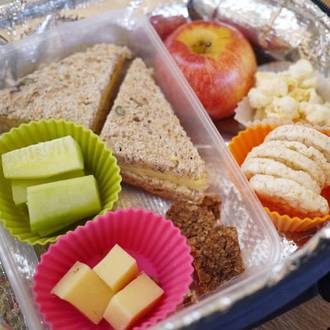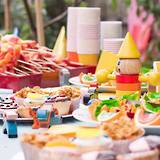Shop
02638
https://www.under5s.co.nz/shop/Hot+Topics+Articles/Food+%26+Eating/10+Lunchbox+ideas+for+toddlers+%26+preschoolers.html
10 Lunchbox ideas for toddlers & preschoolers
|
Lunchboxes can sometimes be a source of enormous stress for parents, especially if your toddler or preschooler is not eating their lunch at daycare or kindy on a regular basis. Here are some useful tips on ways you can help encourage your toddler or preschooler to eat what’s in their lunchbox when they’re away from home.
|
You might also be interested in ...
Party food tips for toddlers & preschoolers
Not sure where to start when it comes to serving party food for toddlers and preschoolers? Here are a few easy tips you can use next time your organising their birthday party.
Understanding fussy eating
As parents we sometimes face the challenge of fussy eating, where our toddler or preschooler may love a particular food one day and then flat refuse it the next - for no apparent reason! By understanding some of the reasons behind their fussy eating, it might make life a little easier for all of you. Here are 10 things you need to know about fussy eating in toddlers and preschoolers.
join usJoin us on social media for all our latest news. |
sign upSign up and receive our latest newsletters. |
|







Not eating lunch is a common problem and not just for children who are picky eaters or have issues eating.
Many toddlers and preschoolers are too busy playing, socialising or just lose track of the eating window and suddenly lunchtime is over, and their lunchbox returns to their daycare bag largely neglected.
10 Lunchbox ideas for toddlers & preschoolers
The more relaxed your toddler or preschooler is in their environment, with the contents of their lunchbox and with the messages that are being imparted, the more likely they are to eat enthusiastically and well.
Here are some useful tips on ways you can help encourage your toddler or preschooler to eat what’s in their lunchbox when they’re away from home.
1. Familiar foods
Away from home, the more familiar foods are to your toddler or preschooler, the more likely they are to get eaten.
Their lunchbox is not the place for learning, especially for anxious eaters.
Road testing new foods at home prior to sending it to kindy or daycare will help support a smoother experience.
2. Child-friendly packaging
Having your toddler’s or preschooler’s food in easy to open and familiar containers will make life easier for them.
Not being able to confidently open packaging by themselves may mean it gets returned to their lunchbox.
Also putting something small like a favourite sticker on a pot can make the difference between acceptance and rejection.
3. Preferred choices
When you’re putting a lunchbox together, bear in mind the temperature, taste and texture of the food.
Hot or cold food can be a make or break their lunch, as can foods that are too squishy, not crunchy or are a new flavour.
Working with your toddler or preschooler and providing food that is within their preferred parameters, as best as practicable, supports better results.
4. Smaller items
Smaller items are often less intimidating to your toddler or preschooler and easier to contemplate than larger portions.
Even sandwiches cut into little pieces are more manageable for little hands.
5. Food presentation
Food presentation is important. We eat with our eyes, so having something that looks good is supportive of better eating.
6. Offer choices
Empowering your toddler or preschooler, within reason, enables them to feel that they have some control over their food.
7. Eating in a relaxed environment
Encourage a relaxed environment. The more relaxed we are the more likely we are to eat. This goes for adults as well as children.
If we are arguing, anxious, upset, distracted or pressured, we are not focused on eating.
Anything that impacts on your toddler’s or preschooler’s comfort level will impede their eating, and away from home small worries are often magnified and this makes eating less easy again.
8. No time pressures
Having a limited amount of time to eat can put pressure on your toddler or preschooler. They feel that their lunchbox must be conquered quickly.
For those who are naturally less comfortable about eating, having a time pressure can dampen their appetite.
Rules that are placed around what must be eaten first or the quantity to be consumed magnifies this. Suddenly the innocuous sandwich seems to have grown and eating it seems insurmountable.
Allowing your toddler or preschooler more control over their eating can dramatically increase the quantity they eat.
9. Offer variety
Try to offer variety and rotate items in your toddler’s or preschooler’s lunchbox. As much as it’s comforting for them to see the same thing every day, it also encourages food jags.
If they then lose interest in a particular option, you may find it challenging to substitute something new. Gentle changes are important.
10. No analysing what they eat
It’s advisable not to analyse your toddler’s or preschooler’s lunchbox when they get home from daycare or kindy. Don’t comment on whether their lunch has been eaten or not.
Knowing that their eating is being analysed can impact on the ability to eat competently.
Source: This article was kindly written for us by The Confident Eater - giving you the tools, the strategies and the confidence to get your picky eater eating.